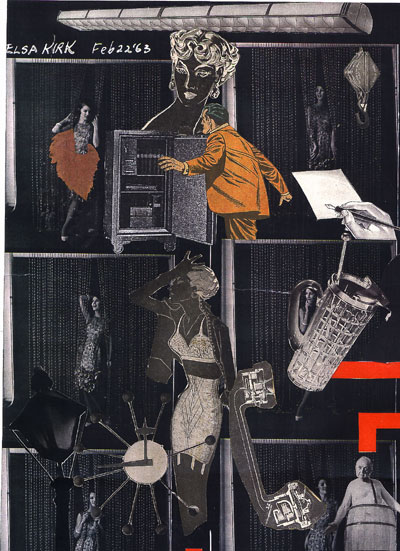PROGRAM ONE: DORSKY, BRAKHAGE & BEAVERS
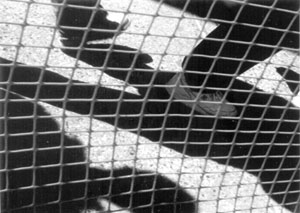
LOVE'S REFRAIN
(Nathaniel Dorsky, U.S., 2001, 22 1/2m)
Perhaps the most delicately tactile in this series, Love's Refrain rests moment to moment on its own surface. It is a coda in twilight, a soft-spoken conclusion to a set of four cinematic songs. - Nathaniel Dorsky
MICRO-GARDEN
(Stan Brakhage, U.S., 2001, 3m)
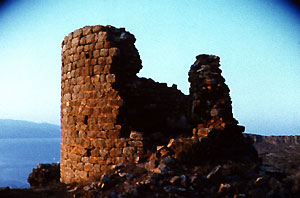
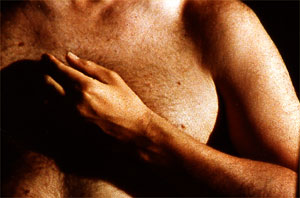
THE GROUND
(Robert Beavers, U.S., 2001, 20m)
What lives in the space between the stones, in the space cupped between
my hand and my chest? Filmmaker/stonemason. A tower or ruin of
remembrance. With each swing of the hammer I cut into the image and the
sound rises from the chisel. A rhythm, marked by repetition, and
animated by variation; strokes of hammer and fist, resounding in
dialogue. In this space which the film creates, emptiness gains a contour
strong enough for the spectator to see more than the image - a space
permitting vision in addition to sight. - Robert Beavers
Total running time: 45 1/2m
Sat Oct 13: 4.30pm; Sun Oct 14: 8:30pm
PROGRAM TWO: CIRCUMFERENCE - FACTUAL TELEPATHY
Each age a lens disseminating their circumference. - Emily Dickinson
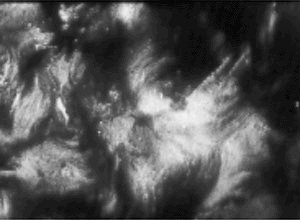
THE OR CLOUD
(Fred Worden, U.S., 2001, 6m)
A guided adventure for the eyeballs. And as such, also, of necessity, an
adventure of the mind (how could it be otherwise?). I believe there is a
current which runs at the core of all beings, call it the life force, a
dynamic which in individuals reflects both the personal and the universal. Up
on the screen, frames in motion, a rushing stream of articulated energy to
resonate with that inner biological current. Adventurous eyeballing then, in
the ideal, an epiphanous moment of mutual recognition and commiseration
between energy forms. "There is a vibration which exists to enrapture and
console us." (Rilke). I like to think this vibration can be detected
streaming out of The Or Cloud.
- Fred Worden
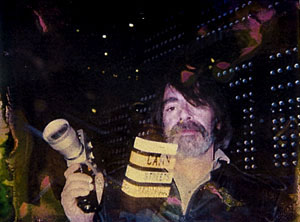
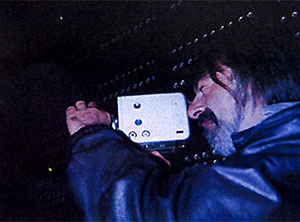
LIGHT LICKS: GET IT WHILE YOU CAN
(Saul Levine, U.S., 2001, Super 8, 6m)
One of a series of films called Light Licks which are made frame by frame often by flooding the camera with enough light to spill beyond the gate into frames left unexposed. Light Licks are ecstatic flicker films inspired by jazz and mystic visionary practice. I saw the Light - Praise the Dark. - Saul Levine
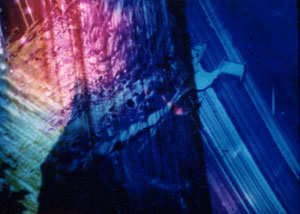
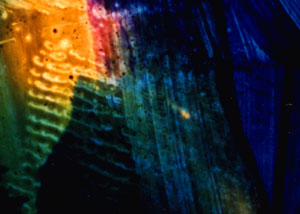
PATINA
(Peter Herwitz, U.S., 2001, 8m)
The title of the film - Patina - suggests many meanings around the phenomenon of "surface" that function in this hand painted film. Taking footage from a distant past and reworking it through paint and montage, creating veils thorough which only glimpses of the photographed images can be seen - becomes not a metaphor for but a visceral expression of the effects of time. The goal of the work is not to be excessively "poignant" or "nostalgic" about the past but rather to celebrate the vibrancy of seeing (and painting) it anew. The process of transforming photography into paint is particularly significant for me as I have been painting on paper and canvas for the past several years and this is my first completed film from this period. - Peter Herwitz
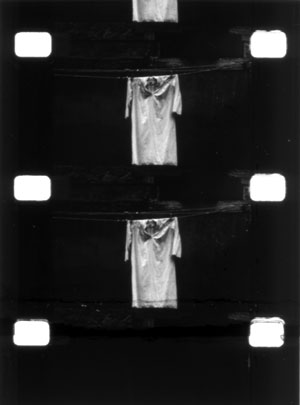
IMPOSSIBLE LOVE
(Jim Jennings, U.S., 2001, 10 1/2m)
The title Impossible Love suggests the miraculous amidst ever-present doom and beauty. Shot in Venice, Italy the film was edited in the camera except the first B & W section. In this work, "illusion" overpowers "reality" and then ends abruptly, tragically, romantically. - Jim Jennings
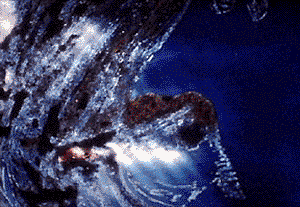 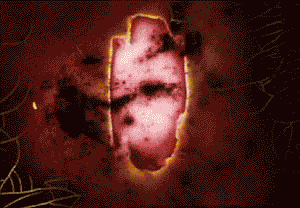
FEAR OF BLUSHING
(Jennifer Reeves, U.S., 2001, 5 1/2m)
Fear of Blushing, a hand-painted film, bursts forth with irrepressible color, corrosion and a menacing soundscape. The film's curious sound/image free-association evokes anxiety, conflict, pleasure and shame. Fragmented visions and voices erupt out of the ominous abstraction and lead you to wonder what frightful thing is buried here. How terrible to look inward & how embarrassing to be revealed by the blush that rises to give us away. This film is beautiful and creepy and doesn't have to be clear about any of this absurdity. A film best appreciated in the immediate, you cannot ponder at this rapid succession of images at 24fps. - Jennifer Reeves
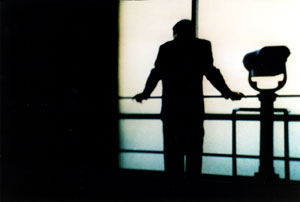
NEBEL (MIST)
(Matthias Müller, Germany, 2001, 35mm, 11m)
Ernst Jandl's Gedichte an die Kindheit ("Poems to Childhood") are composed in a language which the author calls "verkindlicht" ("childlike"); they contain interruptions of style, elements which are incorrect or banal, as well as suggestions of the rhymes and prayers of children. They do not attempt to parody the child's minimal linguistic means of expression, but rather to evoke childlike ways of experiencing, as seen from the position of an ageing man - they attempt to preserve childhood. Nebel (Mist) attempts to translate into images the heterogeneous structure of these poems, their ambivalence, their melancholy and also their scurrilous humor.
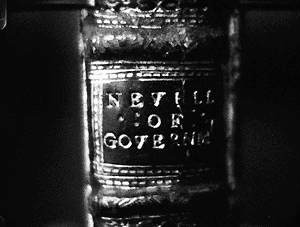
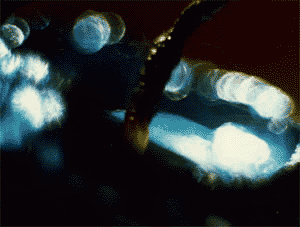
THE ENJOYMENT OF READING (LOST AND FOUND)
(David Gatten, U.S., 2001, 13 minutes, silent, 16mm film)
"All night I sat reading a book, /
Sat reading as if in a book /
Of
somber pages /
It was autumn
and falling
stars /
Covered the shriveled forms /
Crouched in the moonlight /
No
lamp was burning as I read,
/
A voice
was mumbling, 'Everything /
Falls back to coldness /
Even the musky
muscadines /
The melons, the
vermilion
pears /
Of the leafless garden.' /
The somber pages bore no print /
Except the trace of burning
stars /
In
the frosty heaven." — Wallace Stevens
A closely watched candle and an invitation to the dance. William Byrd
booms among his books
while Evelyn
keeps to a quiet window; the volunteer fire brigade sorts through the
ashes and Isaac Goldberg
tells it like
it is. Who read what; when and why?
The first in a series of seven films about the division of landscapes,
objects, ideas and people;
about
letters, libraries, and lovers; auctions, ghosts and the Byrd family of
Virginia during the early
18th
century.

INTERIOR
(Jim Jennings, U.S., 2001, 8 1/2m)
Shot in a Queens, New York apartment, Interior depicts rooms as emotional states of being. The apartment represents the comfort and torment of domestic life. Like a human skulll, it holds images that are imbued with associations both painful and sublime.
- Jim Jennings
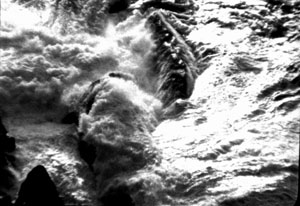
LOOKING AT THE SEA
(Peter Hutton, U.S., 2001, 16 1/2m)
Looking at the Sea is a meditation on the light, color and texture of the land and seascapes along the west coast of Ireland. - Peter Hutton
Total running time: 86m
Sat Oct 13: 6.00pm
PROGRAM THREE: ANDREW NOREN
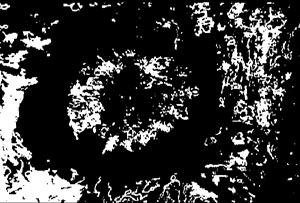
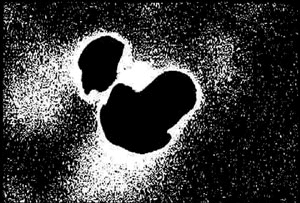
TIME BEING
(Andrew Noren, U.S., 2001, 55m)
Music for light and mind.
The Veil wears thin (who could blame it?)
and "the sparks fly upward!".
Kinesis is better than sleep.
******************
Cinema isn't materials.
It's refined, imaginative seeing...darkness made visible.
It existed long before modern devices, since the first opening of the first animal eyelid...scene one, take one.
When solar light (Sun's thought?) and our own light-of-mind meet, whatever the medium, cinema is possible.
This is a spiritual transaction.
Sun's light emanates, projecting image of "world" through "eye" and into
camera obscura of brain (a "darkened chamber" indeed).
Mind imagines... forming a scenario of intent and desire...and projects that
light back through "eye" onto "world".
We blink. This intermittance creates our dubious dream of "time"...belief
in sequence of scene becomes "before" and "after". Sequence requires
duration...the rest is history!
The eye you see "it" with is the eye "it" sees you with.
Refinement in this area is possible...and desirable.
This can be understood magically.
This is the great primal cinema of animal consciousness...one of the
longest-running movies in show biz... at which we are all captive
spectators, asleep and awake, from first light to final fade.
- Andrew Noren
Total running time: 55m
Sat Oct 13: 9.00pm
PROGRAM FOUR: CARNAL GHOSTS
To sleep immodestly a most, incarnadine and carnal ghost. - Theodore Roethke
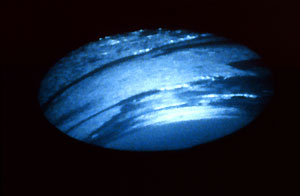
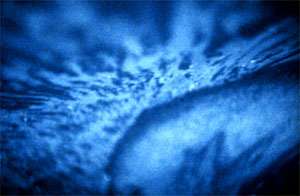
THE DARK ROOM
(Minyong Jang, U.S./Korea, 2001, 4m)
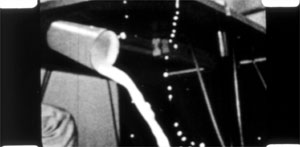
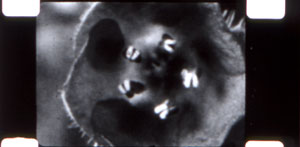
HER GLACIAL SPEED
(Eve Heller, U.S., 2001, 4m)
The world as seen in a teardrop of milk. I set out to make a film about
how unwitting constellations of
meaning rise to a surface of understanding at a pace outside of worldly
time. This premise became a
self fulfilling prophecy. An unexpected interior began to unfold, made
palpable by a trauma that
remains abstract. First ‘words’ since my mother and father died. - Eve Heller
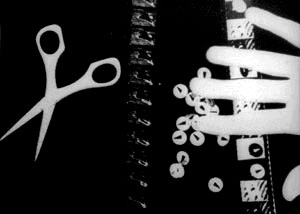 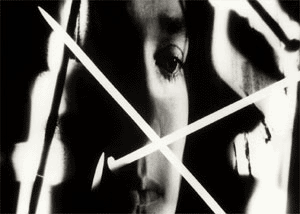
DREAM WORK (FOR MAN RAY)
(Peter Tscherkassky, Austria, 2001, 35mm, b/w, 11 min)
Music: Kiawasch Saheb Nassagh
A woman goes to bed, falls asleep, and begins to dream. This dream
takes
her to a landscape of light and shadow, evoked in a form only possible
through classic cinematography.
Dream Work is - after L’Arrivée and Outer Space - the third
section of
my CinemaScope Trilogy. The formal element binding the trilogy is the
specific technique of contact printing, by which found film footage is
copied by hand and frame by frame onto unexposed film stock. Through
this,
I am able, in a literal sense, to realize the central mechanism by which
dreams produce meaning, the "dream work," as Sigmund Freud described it:
displacement [Verschiebung] and condensation [Verdichtung]. The new
interpertation of the text of the original source material takes place
through its "displacement" from its original context and its concurrent
"condensation" by means of multiple exposure.
Moreover Dream Work positions itself as an homage to Man Ray, who, in
1923 with his famous rayographs in La retour á la raison was the first
artist to use this technique for filmmaking, exposing the image by
shining
light through physical objects onto the film stock. - Peter Tscherkassky
THE LAST LONG SHOT
(Cécile Fontaine, France, 2001, 7m)
MONTESSORI SWORD FIGHT
(Mary Beth Reed, U.S., 2001, 7 1/2 m)
After a young girl discovers her passion for sword fighting, she struggles
to improve her technique. She finds her role model when a band of
Montessori school children invite her to a demonstration given by a
legendary Hollywood master. During intense training sessions, the
children's adroit sword play awakens their competitive instincts. They
rebel against their teacher, and a harrowing duel ensues. The heroine
faces internal turmoil when the Montessori gang forces her to choose
between her master's path and their growing power.
The film combines optically printed and hand processed original and
appropriated imagery.
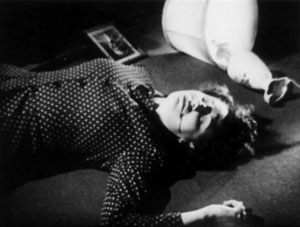
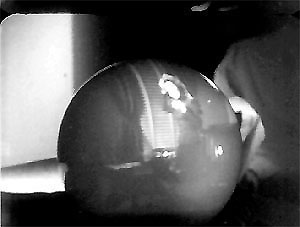
DARK DARK
(Abigail Child, U.S., 2001, 15m)
An uncanny ghost dance of narrative gesture melding four
found story fragments
(Noir, Western, Romance and Chase) upside down and backwards. The music
of Ennio Morricone
provocatively interacts with the images, tantalizing the audience with
webs of cinematic memory,
meaning and elusive folly.
Unlike Child's previous montage of assemblage, this film is a work of
subtraction,
repositioning celluloid and sound tropes into a haunting, strangely
poignant, and nearly always
amazing unfolding.
THE APERTURE OF GHOSTINGS
(Lewis Klahr, U.S., 2001, 14m)
Elsa Kirk - 5m, 1999
Catherine Street - 3m, 2001
Creased Robe Smile - 4 1/2 m, 2001
In the mid 1990’s I unearthed three photographic contact sheets of three
different women in a thrift store in the East Village. Only one was
named
and dated - Elsa Kirk, Feb 22 '63 - but all looked like they were from
the
same photographer and time period. There were 12 images per sheet of
these
Models/Actresses and I found myself quite moved by the strong sense of
aspiration in their poses; a poignant blend of fiction and reality. At
first, I was unable to translate these images into collage animation.
So
instead, I began making xerox enlargements of the sheets which I turned
into a series of flat collages. Eventually these became storyboards for
the
films and led to the hieroglyphic montage style of the completed
trilogy - an approach that I had intuited when first attracted to the
potential of cutouts two decades ago, but had never been able to capture
on
film.
- Lewis Klahr
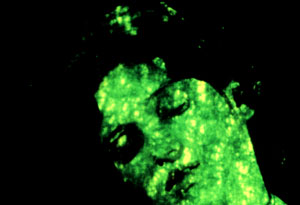
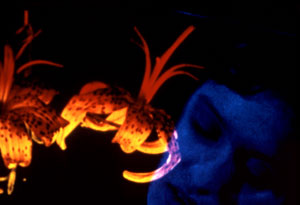
HALLOWED
(Kerry Laitala, U.S., 2001, 11m)
Hallowed is a 16mm film that portrays a mystical voyage made back to the
beginnings of time by an unconscious woman in the throes of a cataleptic
state. During this journey, she find herself in Plato's cave where
flickering flames ignite a prehistoric cinematic reverie of light and
shadow invoking an experience of magical proportions. She is a spectral
being who is transformed from within and viewers traverse the gap
between the mortal coil and the psychical self. The flames of
purification melt away layers of trauma and send the dislocated psyche
back into the realms of the present, emerging whole.
- Kerry Laitala
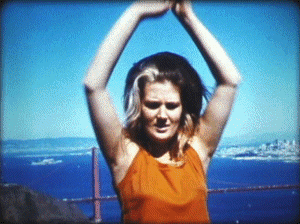 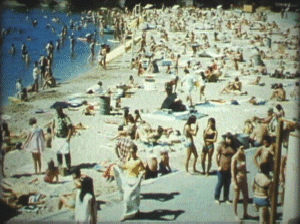
ANGEL BEACH
(Scott Stark, U.S., 2001, 27m)
Anonymous 3-D photographs of bikini-clad women from the early 1970s are
compressed into a two-dimensional cinematic space, triggering an exuberant
visual dance and revealing a troubling and elegiac voyeurism.
Incarnations: free spirits take physical form in young mortal bodies on northern California beaches. Their initial movements are mere flittering gestures and awkward extensions of elbows, knees and shoulders: these are innocents unused to the strictures of the human form, joyful in the wonderment of first physical sensation. Freshly sprung from the ethereal chrysalis, they set to work, busily burrowing and crafting three dimensional baffles, channels and passageways through a screenspace that is too shallow
to contain their neophytic exuberance. - Scott Stark
Total running time: 98 1/2m
Sun Oct 14: 2pm
PROGRAM FIVE: THE MOON STOOD STILL
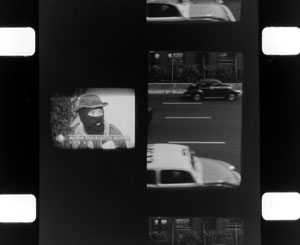 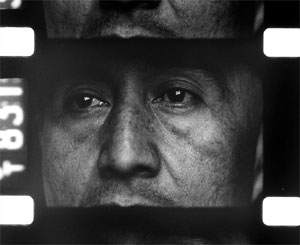
SOLEDAD: MEDITATIONS ON REVOLUTION III
(Robert Fenz, U.S., 2001, 14 1/2m)
Soledad (Solitude) is part three in a series of short, silent,
black and white films that explore the definition of
the word revolution. Shot in Mexico City, San Cristobal de las Casas (in
the Mexican State of Chiapas) and New York City.
The film presents Mexico in a timeless fashion and hopefully evokes a
sense of various periods of time: past, future,
present. The intention is to create a space where the importance of a
tradition of revolution in Mexico might be
contemplated.
Images of New York City were included in an effort to employ one of
the potentials of cinema, that of traveling huge
distances, condensing time and space into a moment and a frame. At the
same time my presence and foreign relationship to
Mexico and its history is implied. - Robert Fenz
NOTES BEFORE THE REVOLUTION
(Ip Yuk-Yiu, Hong Kong, 1999, 16m)
Dear S,
Walking again in Hong Kong, everything looks so familiar and yet equally distant. A sense of displacement strikes me each time when I go back "home." Like a ridiculous tourist, I carried my camera wherever I went and took pictures whenever I could. I don't know exactly why I took those pictures. However one thing I do know for sure is that I want to capture something of this place before everything vanishes in front of my eyes.
Two weeks before Christmas, mother called and told me father was diagnosed with tongue cancer and had to operate within a month. I bought a ticket, packed my stuff and flew back to Hong Kong in the end of 1996.
It was Christmas Eve when I got back. Just at the time when everyone was celebrating Christmas (or perhaps worrying about the fateful coming of 1997), I found myself standing in front of the window and looking at the laundry outside of the house. Somehow the laundry looks awfully sad that day. I can't remember what exactly I was thinking at that time but do remember I stood there for a very long time.
The day before my father's operation, I saw news about Deng Xiaoping at a big TV monitor in frant of a shopping mall. The news said that the old man's health was doing okay. About two months later Deng died and a year later my father passed away.
Y.
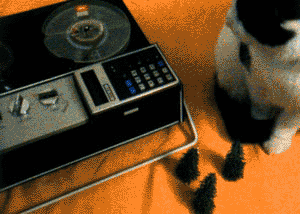
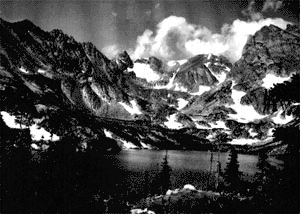
INTRODUCTION TO LIVING IN A CLOSED SYSTEM
(Brittany Gravely, U.S., 2001, 17m)
A fractured educational film which introduces the complexity of the poetry of and the problems created by pastoral dreams of synthetic futures.
"What each of them [Lewis Mumford and R. Buckminster Fuller] has done, really, has been to write philosophical poems celebrating a world that does not truly exist, and perhaps can never exist, even though the poems are true." - Allan Temko
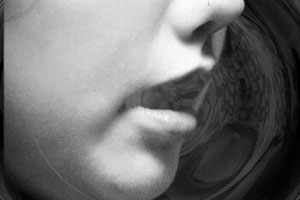
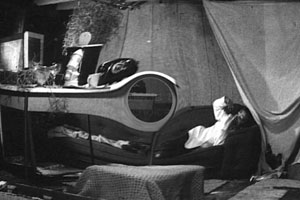
HAVE A NICE DAY ALONE
(Leslie Thornton, U.S., 2001, 7m)
"Elusive and compelling, Have a Nice Day Alone is surpassingly
strange, even for Leslie Thornton, an acknowledged genius of the
unexpected."
—Alan Sondheim
Have a Nice Day Alone is Leslie Thornton’s latest transformation of
media form, and perhaps her most visceral work to date. The piece begins
with a bizarre and hypnotic pulsing, a sort of technological ‘nervous
twitch’ activating the screen. Visible through this pulse is a text
about characteristics of speech, specifically about how gesture
sometimes precedes speech "before the word itself is available." The
image shrinks, flows, collapses, seeming to follow some hidden agenda.
Extreme forms of vocalization - yodelling, and macabre laughter - punctuate
the visual space, as if from an unseen realm. As the image flutters, and
the sound grows delirious, a robotic voice breaks through. Authoritative
in tone, it is unclear whether the voice mimics or generates the text.
Eventually a small child emerges and "calms down" the mechanomorphic
entity. The robotic voice shifts from the position of a voiceover to
that of a subject or character within the "film," as the child in turn
interrogates the voice. No longer exterior, the voice is engaged within
the mise-en-scène, interacting with the child, until it withdraws into
an almost reflective repose, talking to itself. Have a Nice Day Alone
elicits a palpable experience of speech, in the guise of an experience
of "artificial intelligence". Given its dark tone, it ends on a oddly
positive and unexpected note. The piece is as unnerving as it is
pleasurable to watch, extending Thornton’s interest in the vicissitudes
of language and narrative into what feels like a new form of discovery.
It sings like it doesn’t have any conception of music - as if it could be
the very first song. - Thomas Zummer
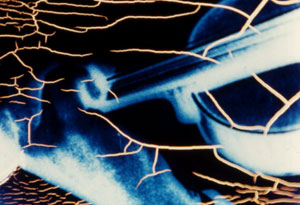
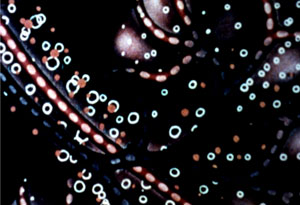
CONQUERED
(Kerry Laitala, U.S., 2001, 14m)
Filmed entirely at the Akademie Schloss Solitude, this film comes from
the depths of a submerged self. She incorporated her own imagery with
found material from German industrial films, most notably a film about a
youth prison. She also ended up using images from a film she brought
from the states entitled The Epic of Everest that summarized the
attempt to reach the summit by mountain climbers George Mallory and
Sandy Irvine in 1924. Mallory's body was just recently discovered below
the North face, killed after a fall, his innards subsequently eaten by
Goraks. Amidst the controversy over whether Mallory made the summit or
not, her intent in using the Everest imagery was to describe a feeling of
a frozen landscape as emotional state. As she was awestruck at its
extreme beauty and chill, she felt that it perfectly portrayed an
immobilized catatonic state analogous to the darkness and snow covered
quietude. She was interested in simultaneously describing a psychic
voyage combined with an interior vision of a distorted mindscape. Matter
becomes transformed into a morass of material incoherence. She wanted the
viewer to become lost in the imagery and to feel as though they were
being dangled over the edge of a precipice. She merged the materials:
celluloid base with alchemically manipulated surface, and found a
way to crack the emulsion to yield a fragile encumbered
palate - a veritable testament to the forces of organic catalysts in
motion. Thomas Mann's Magic Mountain is evoked as a spectator is drawn
into a confined consumptive state. When she returned home from the
holidays she would joke with the relatives she had "Just come back from
the sanitarium, I mean the castle." X-ray imagery of a ribcage in the
film alludes to the need to see beneath the recesses, evoking a 19th-century melancholic, tubercular state. Illness or the illusion of illness
becomes the manifestation of the unbalanced cacophony. Cinema becomes the
only means of escape from an unstable worldview one million miles from
the self. - Kerry Laitala
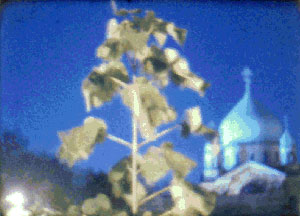
THEIR IDOLS DISINTEGRATE
(Jennifer Fieber, U.S., 2001, 12m)
I am drawn to locations which are neutral and lack an obvious human
signature. Each site expresses a mute dignity, impervious to its busy,
oppressive or absurd surroundings. These empty stages allow room for
individual response to the equivocal play of human vanity, if one
chooses to
pay attention. - Jennifer Fieber
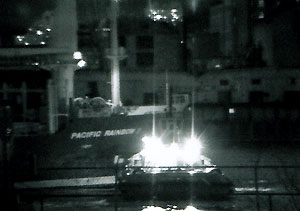
GOING TO THE OCEAN
(Matt McCormick, U.S., 2001, 8m)
A textured mood swing and a trip to the beach. What does it mean to be
sea worthy? Answers questioned in a slow-motion memory lapse. - Matt McCormick.
Production:
night-vision video (transferred to film) and found Kodachrome.
Improvised noise soundtrack: trains/static/melodian.
Total running time: 88 1/2m
Sun Oct 14: 6pm
|
